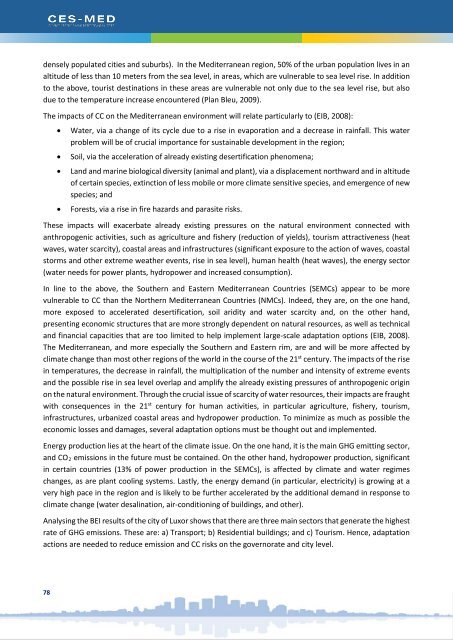130218_Luxor-Egypt SECAP Final
You also want an ePaper? Increase the reach of your titles
YUMPU automatically turns print PDFs into web optimized ePapers that Google loves.
densely populated cities and suburbs). In the Mediterranean region, 50% of the urban population lives in an<br />
altitude of less than 10 meters from the sea level, in areas, which are vulnerable to sea level rise. In addition<br />
to the above, tourist destinations in these areas are vulnerable not only due to the sea level rise, but also<br />
due to the temperature increase encountered (Plan Bleu, 2009).<br />
The impacts of CC on the Mediterranean environment will relate particularly to (EIB, 2008):<br />
• Water, via a change of its cycle due to a rise in evaporation and a decrease in rainfall. This water<br />
problem will be of crucial importance for sustainable development in the region;<br />
• Soil, via the acceleration of already existing desertification phenomena;<br />
• Land and marine biological diversity (animal and plant), via a displacement northward and in altitude<br />
of certain species, extinction of less mobile or more climate sensitive species, and emergence of new<br />
species; and<br />
• Forests, via a rise in fire hazards and parasite risks.<br />
These impacts will exacerbate already existing pressures on the natural environment connected with<br />
anthropogenic activities, such as agriculture and fishery (reduction of yields), tourism attractiveness (heat<br />
waves, water scarcity), coastal areas and infrastructures (significant exposure to the action of waves, coastal<br />
storms and other extreme weather events, rise in sea level), human health (heat waves), the energy sector<br />
(water needs for power plants, hydropower and increased consumption).<br />
In line to the above, the Southern and Eastern Mediterranean Countries (SEMCs) appear to be more<br />
vulnerable to CC than the Northern Mediterranean Countries (NMCs). Indeed, they are, on the one hand,<br />
more exposed to accelerated desertification, soil aridity and water scarcity and, on the other hand,<br />
presenting economic structures that are more strongly dependent on natural resources, as well as technical<br />
and financial capacities that are too limited to help implement large-scale adaptation options (EIB, 2008).<br />
The Mediterranean, and more especially the Southern and Eastern rim, are and will be more affected by<br />
climate change than most other regions of the world in the course of the 21 st century. The impacts of the rise<br />
in temperatures, the decrease in rainfall, the multiplication of the number and intensity of extreme events<br />
and the possible rise in sea level overlap and amplify the already existing pressures of anthropogenic origin<br />
on the natural environment. Through the crucial issue of scarcity of water resources, their impacts are fraught<br />
with consequences in the 21 st century for human activities, in particular agriculture, fishery, tourism,<br />
infrastructures, urbanized coastal areas and hydropower production. To minimize as much as possible the<br />
economic losses and damages, several adaptation options must be thought out and implemented.<br />
Energy production lies at the heart of the climate issue. On the one hand, it is the main GHG emitting sector,<br />
and CO 2 emissions in the future must be contained. On the other hand, hydropower production, significant<br />
in certain countries (13% of power production in the SEMCs), is affected by climate and water regimes<br />
changes, as are plant cooling systems. Lastly, the energy demand (in particular, electricity) is growing at a<br />
very high pace in the region and is likely to be further accelerated by the additional demand in response to<br />
climate change (water desalination, air-conditioning of buildings, and other).<br />
Analysing the BEI results of the city of <strong>Luxor</strong> shows that there are three main sectors that generate the highest<br />
rate of GHG emissions. These are: a) Transport; b) Residential buildings; and c) Tourism. Hence, adaptation<br />
actions are needed to reduce emission and CC risks on the governorate and city level.<br />
78

















